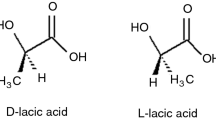Abstract
Interpenetrating polymer network (IPN) hydrogels based on poly(hydroxybutyl methacrylate) (poly(HBMA)) and poly(2-hydroxyethyl methacylate) (poly(HEMA)) were constructed by a sequential IPN method. 1,6-hexanedioldiacrylate (HDDA) was used as a crosslinker and erythrosine/triethanolamine (TEOA) system to initiate radical polymerization after UV light exposure. Effect of pH on the swelling behaviour of these IPNs was investigated. The results showed that the IPN hydrogels exhibited negatively change of swelling behaviour with variation in pH from 2 to 11 and the diffusion of water molecules was caused by the electrostatic attraction between polar groups (–OH) in both IPN and H2O that occur when a hydrogen (H) atom bound to the oxygen (O) which have a high electronegativity. Sample modeling was used to rationalize the experimental results obtained. Good correlation between theoretical and experimental results was mentioned.













Similar content being viewed by others
References
Rodrigues IR, Forte MMC, Azambuja DS, Castagno KRL (2007) Synthesis and characterization of hybrid polymeric networks (HPN) based on polyvinyl alcohol/chitosan. React Funct Polym 67:708
Pourjavadi A, Mahdavinia GR (2006) Superabsorbency, pH-sensitivity and swelling kinetics of partially hydrolyzed chitosan-g-poly (acrylamide) hydrogels. Turk J Chem 30:595
Gaharwar AK, Peppas NA, Khademhosseini A (2014) Nanocomposite hydrogels for biomedical applications. Biotechnol Bioeng 111:441
Demitri C, Scalera F, Madaghiele M, Sannino A, Maffezzoli A (2013) Potential of cellulose-based superabsorbent hydrogels as water reservoir in agriculture. Int J Polym Sci 2013:6
Mguyen MK, Alsberg E (2014) Bioactive factor delivery strategies from engineered polymer hydrogels for therapeutic medicine. Prog Polym Sci 39:1235
Tan H, Marra KG (2010) Injectable, biodegradable hydrogels for tissue engineering applications. Materials 3:1746
Vashist A, Vashist A, Gupta YK, Ahmad S (2014) Recent advances in hydrogel based drug delivery systems for the human body. J Mater Chem B 2:147
Sperling LH, Hu R (2003) Interpenetrating polymer networks. In: Utracki LA (ed) Polymer blends handbook. Springer, Dordrecht, pp 417–447
Mandal B, Ray SK (2014) Swelling, diffusion, network parameters and adsorption properties of IPN hydrogel of chitosan and acrylic copolymer. Mater Sci Eng, C 44:132
Lohani A, Singh G, Bhattacharya SS, Verma A (2014) Interpenetrating polymer networks as innovative drug delivery systems. J Drug Deliv 2014:11
Boudraa K, Bouchaour T, Maschke U (2008) Swelling of acrylic interpenetrating polymer networks in liquid crystals. Macromol Symp 273:33
Hamri S, Bouchaour T, Maschke U (2014) Erythrosine/triethanolamine system to elaborate crosslinked poly (2‐hydroxyethylmethacrylate): UV‐photopolymerization and swelling studies. Macromol Symp 336:75
Encinas MV, Rufs AM, Bertolotti SG, Previtali CM (2009) Xanthene dyes/amine as photoinitiators of radical polymerization: a comparative and photochemical study in aqueous medium. Polymer 50:2762
Yu H, Chen Q, Zhang Z, Zhu J, Cheng Z, Zhou N, Zhang W, Zhu X (2012) 60Co γ-irradiation-initiated RAFT polymerization of VAc at room temperature. React Funct Polym 72:153
Sato R, Kawakami T, Tokuyama H (2014) Preparation of polymeric macroporous hydrogels for the immobilization of enzymes using an emulsion-gelation method. React Funct Polym 76:8
Liu F, Jiang X, Bao S, Wang R, Sun B, Zhu M (2015) Effect of hydroxyapatite whisker surface graft polymerization on water sorption, solubility and bioactivity of the dental resin composite. Mater Sci Eng, C 53:150
Ritger PL, Peppas NA (1987) A simple equation for description of solute release II. Fickian and anomalous release from swellable devices. J Control Release 5:23
Berens AR, Hopfenberg HB (1978) Diffusion and relaxation in glassy polymer powders: 2. Separation of diffusion and relaxation parameters. Polymer 19:489
Acknowledgments
This work was supported by Research on Macromolecules Laboratory (LRM), Faculty of Science—Tlemcen University, Algeria.
Author information
Authors and Affiliations
Corresponding author
Rights and permissions
About this article
Cite this article
Hamri, S., Bouchaour, T. pH-dependent swelling behaviour of interpenetrating polymer network hydrogels based on poly(hydroxybutyl methacrylate) and poly(2-hydroxyethyl methacrylate). Int J Plast Technol 20, 279–293 (2016). https://doi.org/10.1007/s12588-016-9155-2
Received:
Accepted:
Published:
Issue Date:
DOI: https://doi.org/10.1007/s12588-016-9155-2




